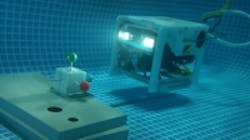Autonomous underwater robot targets search and tracking operations
Researchers from Okayama University have developed an autonomous underwater vehicle (AUV) equipped with two CCD cameras that is designed for search and tracking operations over long durations of time in open water.
MORE ARTICLES
Choosing a 3D vision system for automated robotics applications
Cornell vision-enabled underwater vehicle seeks fourth straight RoboSub Competition win
The robot utilizes the university’s "Move on Sensing" 3D visual servo CCD technology in order to perform object recognition in search operations. Two *CCD cameras that are located at the front of the robot track “optical induction markers” on a target, then algorithms are used to match the marks with points on 3D computer models of the target.
"The two CCD cameras of the MOS visual servo system are located at the front of the robot to track ‘optical induction markers’ emitted by light sources on the target," said Mamoru Minami, professor at the Graduate School of Natural Science and Technology, Okayama University. "We use genetic algorithms (GA) to match the CCD images with 3D models of the target to dock with the target. Ultimately, we do not need to dock to recharge. We could use induction based recharging that we enable much easier operation over long periods of time."
The robot is able to move autonomously while taking into account changes in the position of the target, with the capability of tracking targets moving at speeds up to 10 mm/sec, according to an Okayama University press release.
Okayama University’s MOS/AUV is expected to be used in areas including decontamination of radiation contaminating the floors of seas, oceans and lakes; exploration of ocean floors for materials such as methane hydrate and rare earth metals; maintenance of underwater telecommunications cables; environmental monitoring and surveys of marine life; underwater mines; recovering space debris; and lifesaving.
"We can envisage applications not related to underwater activities," said Minami. "For example docking space vehicles and using autonomous robots to build bases on the Moon. It’s a really exciting invention with many applications."
*Camera vendor not provided
View the press release.
Share your vision-related news by contacting James Carroll, Senior Web Editor, Vision Systems Design
To receive news like this in your inbox, click here.
Join our LinkedIn group | Like us on Facebook | Follow us on Twitter | Check us out on Google +
About the Author

James Carroll
Former VSD Editor James Carroll joined the team 2013. Carroll covered machine vision and imaging from numerous angles, including application stories, industry news, market updates, and new products. In addition to writing and editing articles, Carroll managed the Innovators Awards program and webcasts.
